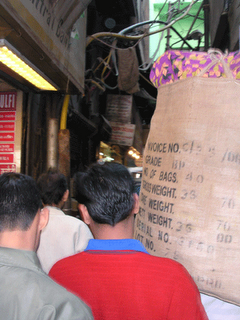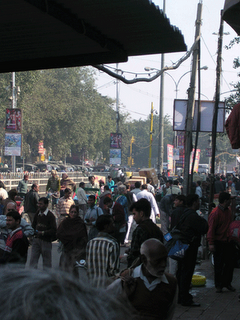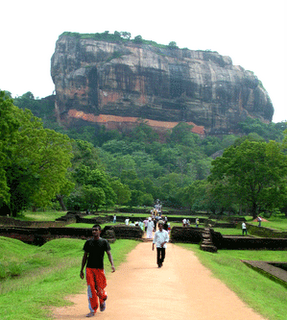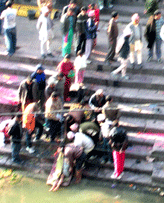

More tales of death and destruction. Shiva, the Hindu god who controls these things, seems never to take a holiday. Tourism in South Asia some days feels like five parts of old life and death stories and one part stories of fresh life and death--two weeks ago the bombing in Colombo; two years and two days ago the tsunami.
“When tsunami come, they all die,” our Muslim guide, Malik, tells us as we drive along the coast road of south Sri Lanka. “This was my friend … he is also guide … and Japanese tourists he take to national park. But I am with two Russians in Sigiriya. And, now, I think of what if. He was good friend. Sometimes I take Japanese. Maybe that day? Who knows these things?”
In the headlights, we could see what looked like bombed out remnants of buildings. There would be a row of them and, then, a mile or more of new structures glistening in bright paints. And, everywhere, the palms stood, survivors, their green fronds vivid against the night sky.
“One thousand two hundred people,” Malik says flooring the gas pedal and swerving around a bus. The road was narrow before the tsunami and has not improved since. “One thousand two hundred people were killed on the train.” It was a train running from Colombo to Galle, and it was overtaken by the tsunami wave. The cars were derailed and jumbled up. When the water left, the train looked like the victim of a childish temper tamtrum, its occupants as broken as the cars.
I see gravestones … rows of them … alongside the road. “The graves?” I ask. “From the people killed on the train?”
“These are local people. Twenty thousand dead here.”
I wonder, peering into the dark, watching the scenes illumined by our headlights. by passing store fronts, by village street lights … I wonder how it was that day. I wonder and am very glad I wasn’t here. So many gravestones. They don’t line the road but are clustered, a group of them here, another there, fitted among gardens and structures. It’s like the living have infiltrated a cemetery.
A day later I meet Dharanga, an auto rickshaw driver. “I was pastry chef at hotel on beach, but hotel ruin now,” he says. “That day I not at hotel. Why I alive. All there die. See!” his arm shoots out of the side of the little vehicle as he points at the tunnel under Galle fort’s walls. He fumbles for words in English. “Water come. All gone.”
He stops so that I can look around at what is now a big plaza where men are busy laying paving stones. A solitary tree stands near one end, casting shade over an area that might once have held a house. There were many buildings around it … once. Now, except for the tree, it’s a broad expanse of … nothing. ‘All gone.’
The tsunami roared into the protected Galle harbor, surging through the mouth of the bay, hitting the outer walls of the old Portuguese fort first and skirting it. The master builders of four hundred years ago would be proud if they knew. The fort’s exterior facings held. Centuries of use and the wall’s strength defied the power of water. But the tsunami wasn’t stopped, only diverted. It came on, rushing into the harbor, laying waste to the town of Galle, then doing what water does best—backtracking and infiltrating the fort through its open, bay-facing gates. The forty-plus foot long tunnel that led through the impenetrable walls gave the flood a channel, which it used as inevitably as a river follows its bed. Seconds after the wave first reached land, water exploded into the fort’s interior, laying waste to all in its path.
“All dead,” Dharanga says of the empty plaza. He engages the gas, and we putt putt through the tunnel to emerge in the harbor area. On one side the road follows the fort. On the other a fleet of fishing boats are pulled up on the sand, the fishermen just beginning to emerge from their little shacks.
“All gone. Dead,” Dharanga repeats.
We avoid a bus that momentarily looms over us, and Dharanga pulls out his wallet and extracts a card that certifies he is a certified master pastry chef and instructor. “My hotel lost. Job lost. Tourists lost. This is why I drive tuk tuk.” He uses the local word for auto rickshaw.
The Lighthouse Hotel, where we’re staying, is an exception to Dharanga’s general statement. It sits high above the beach, buttressed by an impressive barrier of rocks where on a normal day waves crash and spume flies high in the air.
“The water came up to the second floor,” an IT tech says as we work over internet access for my computer. Gradually, I develop a mental picture of how it was here. The tsunami struck and rose, flooding through the ground floor on the beach side. But that’s the second floor on the land side. Water surged around the hotel and filled the lower two stories but, since the hotel is built in layers over the top of a rise, its foundations weren’t compromised and the bulk of the building was untouched. “Only one person was killed,” the tech adds, “There. Now, just add a password and you’ll be on line.”
“Where were you?” I ask.
“I was driving to another JetWing hotel … the one that was destroyed. When the water came I jumped out of my car and ran to high ground. I was safe. But if I had been at that hotel … .” He shakes his head. “They all died. They all died. My friends there.”
It is two years and two days since the tsunami. We walk the beach, looking for shells, watching the waves break on a rock barrier and, occasionally, wading into the surf. Then, we feel the power of the sea through the little line of water sweeping at our legs. “Whoops!” A bigger wave swoops in and knocks me off my feet. I laugh in the foamy, warm water, sand slipping away under my bottom, tickling.
Two years and two days have passed. Everyone along this coast has a story. In Sri Lanka, memories of the tsunami are equivalent to 9/11 for us. Everyone remembers where they were, what they did, who they lost, who survived. There are tales of miraculous saves and tragic deaths. But mostly the two-year anniversary boils down to the question of what happened to the survivors.
“The government gave me three payments of 5,000 rupees each ($500). That was all.” Dharanga says. “Now, I rent tuk tuk. Before I bake pastry. If tourists come again?”
He hopes the hotels will rebuild and the ones that still exist will fill up. But I am here now, so I reach into my pocket for a generous tip.















